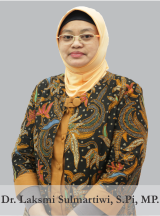Antibacterial Activity of Crude Extract Red Algae Eucheuma spinosum Against Staphylococcus epidermidis Bacteria Growth
Downloads
The use of seaweed (Eucheuma spinosum) as a source of bioactive ingredients from algae has not been widely carried out, even though it has secondary metabolites that are thought to have antibacterial activity. The purpose of this study was to determine the inhibitory activity of the crude extract of red algae E. spinosum on the growth of Staphyloccus epidermidis bacteria in vitro. The working method used is an experimental and qualitative research design. Extraction of E. spinosum used maceration with 96% ethanol solvent and evaporated using a rotary evaporator to obtain a crude extract yield of 1.54%. The phytochemical screening test used thin layer chromatography and precipitation tests. The results of phytochemical screening showed that crude extract of Eucheuma spinosum contained alkaloids, flavonoids, terpenoids and saponins. These compounds are thought to have the potential to have antibacterial activity. The antibacterial test was based on a comparative study of the literature using the disc diffusion method (Kirby-Bauer test) with a positive control of Clindamycin 10μl/ml and a negative control of distilled water. Comparison of the literature on the results of the antibacterial activity test is thought to be effective for treating acne-causing bacteria, namely Staphylococcus epidermidis with an average inhibition of 26.5 mm (30 μl). The antibacterial activity is because seaweed contains secondary metabolites such as flavonoids, alkaloids, terpenoids, and saponins. The need for herbal therapy to treat diseases caused by Staphylococcus epidermidis bacteria to reduce bacterial resistance to antibiotics.
Alen, Y, Agresa. F.L, Yuliandra, Y. 2017. Analisis Kromatografi Lapis Tipis (KLT) dan Aktivitas Anthiperurisemia Ekstrak Rebung Schizostachyum brachyladum Kurz (Kurz) pada Mencit Putih Jantan. Jurnal. Sains Farmasi, Vol 3 (2) : 146-152.
Anggraeni, V.J., Wahyu, T.S., Kusriani, H., Kurnia, D. 2019. Thalassiosira sp terhadap Bakteri Staphylococcus aureus, Staphylococcus epidermidis dan Propionibacterium acne. Jurnal Kimia Riset. 4(1) : 62-73.
Bouhlal, R., Riadi, H., Bourgougnon, N. 2013. Antibacterial Activity Of The Extracts Of Rhodophyceae From The Atlantic And The Mediterranean Coasts Of Morocco. Journal of Microbiology, Biotechnology, and Food Sciences. 2 (6) 2431-2439.
Darsana, I.G.O., I.N.K. Besung & H. Mahatmi. 2012. Potensi Daun Binahong (Anredera cordifolia (Tenore) Steenis) dalam Menghambat Pertumbuhan Bakteri Escherichia coli secara In Vitro. Indonesia. Medicus Veterinus, 1(3): 337-351.
Dinas Perikanan Kabupaten Sumenep. 2017. Laporan Kinerja Instansi Pemerintah. Diakses dari dataprimer.sumenepkab.go.id. 9 Juli 2019.
Ermawati, D.E., Ramadhani, C.I. 2019. Formulation of Anti-Acne Gel of Moringa oleifera L Ethanolic Extract and Antibacterial Test on Staphylococcus epidermidis. Journal of Food and Pharmaceutical Sciences. 7(1) : 34-44.
Hanapi, A., Sahro, N.M., Ningsih, R., Nasichuddin, A. 2013. Uji Toksisitas dan Identifikasi Senyawa Ekstrak Alga Merah (Eucheuma cottonii) Terhadap Larva Udang Artemia salina Leach. Alchemy Journal of Chemistry. 2(3) : 170-177.
Narulita, W., Indarto, I., Anggoro, B.S, Novitasari, A. 2019. Aktivitas Antibakteri Ekstrak Daun Binahong Terhadap Propionibacterium acnes. BIOSFER: Jurnal Tadris Biologi. 10(1) : 67-78.
Manu R. R. S. 2013. Aktivitas Antibakteri Ekstrak Etanol Daun Beluntas (Pluchea indica L) terhadap Staphylococcus aureus, Bacillus subtillis dan Pseudomonas aerugenosa. Jurnal Ilmiah Mahasiswa Universitas Surabaya. Vol. 2 (1).
Mardiyah, U., Fasya, G.A., Fauziyah, B., Amalia, S. 2014. Ekstraksi, Uji Aktivitas Antioksidan dan Identifikasi Golongan Senyawa Aktif Alga Merah Eucheuma spinosum dari Perairan Banyuwangi. Alchemy Journal of Chemistry, 3(1): 39-46.
Mulyani, Y., Dadan, H., Isbiyantoro., Yeny, F. 2017. Ekstrak Daun Katuk (Sauropus androgynous (L) Merr) Sebagai Antibakteri Terhadap Propionibacterium acnes dan Staphylococcus epidermidis. Jurnal Farmasi Lampung, 6 (2) : 51-52.
Narulita, W., Indarto, I., Anggoro, B.S, Novitasari, A. 2019. Aktivitas Antibakteri Ekstrak Daun Binahong Terhadap Propionibacterium acnes. BIOSFER: Jurnal Tadris Biologi. 10(1) : 67-78.
Nurjanah, Nurilmala, M., Anwar, E., Luthfiyana, N., Hidayat, T. 2017. Identification of Bioactive Compounds of Seaweed Sargassum sp. and Eucheuma cottonii Doty as a Raw Sunscreen Cream. Proceedings of the Pakistan Academy of Sciences: B. Life and Environmental Sciences, 54 (4): 311318.
Nurhayati, T., Han, R., Nurliani, B. 2011. Production of Mangium (Acacia mangium) Wood Vinegar and Its Utilization. Journal of Forestry Research, 2(1): 13-15.
Purwanto, S. 2015. Uji Aktivitas Antibakteri Fraksi Aktif Ekstrak Daun Senggani (Melastoma malabathricum L) Terhadap Escherichia coli. Jurnal Keperawatan Sriwijaya. 2(2) : 84-92. ISSN : 2355-5459.
Radji, M., Fauziah, S., Aribinuko, N. 2011. Antibiotic Sensitivity Pattern of Bacterial Pathogens in the Intensive Care Unit of Fatmawati Hospital, Indonesia. Asian Pasific Journal of Tropical Medicine, 1(1): 39-42.
Ratnaningtyas, L.S. 2013. Optimasi Komposisi Fase Gerak pada Pemisahan Campuran Deksametason dan Dekslorfeniramin Maleat Secara Kromatografi Lapis Tipis Densitometri. Skripsi. Fakultas Farmasi. Universitas Sanata Dharma. Yogyakarta.
Siregar, A.F., Sabdono, A., Pringgenies, D. 2012. Potensi Antibakteri Ekstrak Rumput Laut terhadap Bakteri Penyakit Kulit Pseudomonas aeruginosa, Staphylococcus epidermidis, dan Micrococcus luteus. Journal of Marine Research. 1(2): 152-160.
Stahl, E. 2013. Thin-Layer Chromatography: A Laboratory Handbook. New York: Springer-Verlag.
Susilowati, R., Sabdono, A., Widowati, A. 2015. Isolation and Characterization of Bacteria Associated with Brown Algae Sargassum spp. from Panjang Island and Their Antibacterial Activities. Procedia Environmental Sciences. 23 : 240 246.
Wahyulianingsih, Handayani, S., & Malik, A. (2016). Penetapan kadar Flavonoid Total Ekstrak Daun Cengkeh (Syzygium aromaticum(L.) Merr dan Perry). Jurnal Fitofarmaka Indonesia. 3(2) : 189.
Copyright (c) 2022 Journal of Marine and Coastal Science

This work is licensed under a Creative Commons Attribution-NonCommercial-ShareAlike 4.0 International License.













